I fully agree with this article by David Finegold in Indian Express. Following are some excerpts.
… Unfortunately, the proposed legislation to encourage the leading universities from around the world to set up campuses in India is unlikely to achieve the desired objectives. Below are 10 reasons why these top universities are not likely to come in the numbers projected, one possible exception to this scenario, and a suggested alternative approach to reform that could meet the desired objective more quickly.
… The timing of the bill could not have been worse for encouraging the world’s best universities to invest in creating new campuses.
… When Sibal toured the US in the fall of 2009 to recruit the leading private universities, part of his pitch was they should follow the lead of IT and business service multinationals and come to India because it offers a source of high-quality, low-cost talent. The problem with this analogy is that leading universities are not driven by a desire to lower labour costs or increase profits; … Rather, India should appeal to their desire to attract the world’s most able students,
…The bill likewise misunderstands the motives of many of the Indian students now travelling abroad to obtain their degrees. … This ignores the reality that, even with the huge growth in opportunities in the Indian economy, an equal or greater part of students’ motivation for studying abroad is the chance to get a job in that country after graduation.
… With a few notable exceptions — e.g. Wharton’s decision to create a small campus in Silicon Valley, the recent forays into Dubai and Singapore — most of the universities that India is seeking to recruit have resisted the temptation to grow for centuries, …
… As a subset of these universities looks to establish foreign campuses, they are likely to be most attracted to those countries which offer them generous incentives that both reduce upfront costs and the risks associated with global expansion. … India is not proposing any such financial inducements.
… those who opt for a PhD and are able to publish in the top academic journals in their field — the talent pool that would interest leading foreign universities — are in demand in a global labour market that enables them to work anywhere in the world. Attracting them or their peers from other countries to campuses in India would mean paying competitive salaries that would erase India’s cost advantage.
… The combined effect of the above factors is that those institutions which are most likely to be attracted to the Indian market are those that the Indian government least wants: the lower-quality providers that treat higher education as a way to make money, rather than focusing on world-class research and the quality of the learning experience.
... One attractive option for a few of the leading foreign universities might be the endowment of an Indian campus by a wealthy individual (perhaps one of their alumni) and/or corporation. This was the way in which many of India’s most respected private higher education institutions were first created — i.e. the Tata Institutes in different disciplines and The Indian School of Business — and how many of the leading private US universities (Stanford, Carnegie Mellon, University of Chicago, Duke) came into being. A key element that enabled these institutions to become and remain world-class, however, was that the founding individual/family gave the resources with relatively few strings attached, and allowed the university to govern itself, rather than the much more hands-on approach of many of the universities created more recently by Indian industrialists.
… However, an alternative strategy is already working. It promises to expand the quality and quantity of Indian higher education and provide greater benefits to the foreign universities. This strategy encourages the formation of more dual- or joint-degree partnerships between Indian and foreign institutions.
The writer is dean of the School of Management and Labor Relations at Rutgers University. He and colleagues are conducting research for a book on “Developing the Skills of the 21st Century Workforce: Comparing the Education and Training Systems of India and China.”
The part in red is close to (but not 100%) what Vedanta University seems to be about. Unfortunately many in Odisha do not understand it.
The underlined part is already happening. One major instances is the partnership between Asian Institute of Public Health in Bhubaneswar and University of Maryland Medical school in Baltimore.
April 2nd, 2010
MP Pyari Mohapatra’s question is in page 21 Q 1456 of http://164.100.47.5/EDAILYQUESTIONS/sessionno/219/830RS.pdf. See below for the question and the answer.
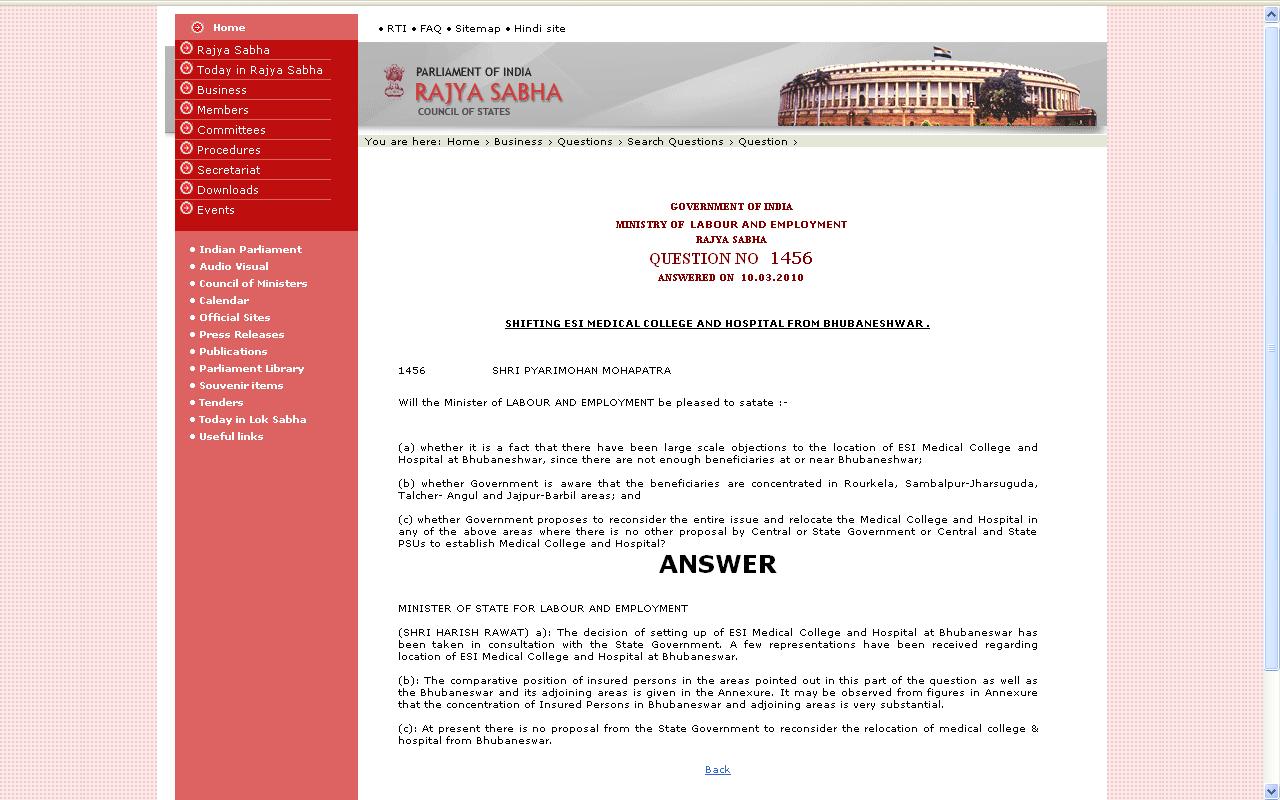
The above Q&A is referred to in the Pioneer report http://dailypioneer.com/246034/ESIC-issue-Labour-Minister-fumbles-at-Rourkela-meet.html. From the answer it is not clear what the IP situation really is. While the Bhubaneswar area may have very substantial number of IPs, there could still be more in the Rourkela area and the ESIC medical college should then be established in Rourkela. So saying "very substantial" is not meaningful. I could not find the annexure mentioned in the Rajya Sabha answer.
If someone has the real data, please publish it so that any manipulation will become clear.
(Note: The discussion in this thread will be restricted to exact IP numbers in Odisha and nothing else.)
April 1st, 2010
Following is an excerpt from a report in Deccan Herald.
… the Centre will spend Rs 1,300 cr in upgrading the infrastructure and student accommodation capacity of government medical colleges in state capitals and Rs 1,200 cr in setting up 250 nursing schools, Health Minister Ghulam Nabui Azad said here at a Planning Commission meeting on infrastructure development.
Nursing training will be a key constituent of the government’s health scheme. At the moment, more than nine lakh nurses are registered with the Nursing Council of India.
March 28th, 2010
Update2: Excerpts from Expressbuzz.
An MoU was signed between Ravenshaw University Vice- Chancellor Devdas Chotray and AIPH founder secretary Dr Pinaki Panigrahi for the launch of the Masters in Public Health (MPH) programme. Besides imparting comprehensive skills in public health, the course would turn students into experts on occupational and environmental health, public health informatics and clinical and behavioural sciences. With an extensive hands-on experience, they will pass out as professionals ready to shoulder the challenges of the rise of chronic, infectious, occupational and environmental health problems that are vital contributors to high infant and maternal mortality in the State.
The first of its kind programme in Orissa is accreditated by the Council of Education on Public Health (CEPH) under the USA Government. The students would also gain credit points that would facilitate pursuance of higher studies in the US if they so willed.
But, foremost, the programme would churn out the much needed manpower in the State. There are at least 10,000 jobs for public health professionals in the district and block level under the National Rural health Mission. This apart, public health professionals are much sought after by private health sector enterprises, national and international agencies.
Update: Dharitri’s take on this.
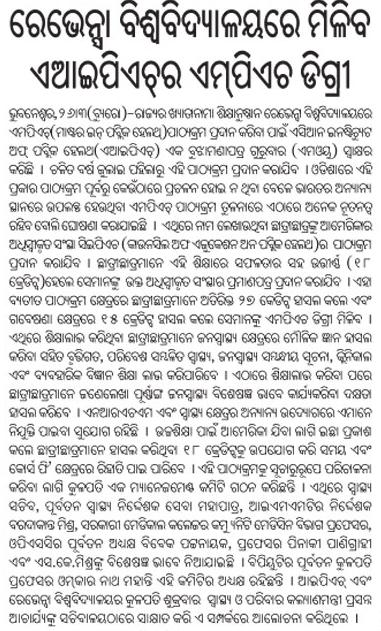
The Asian Institute of Public Health in Bhubaneswar has announced a PG Diploma program in Public Health Informatics. This course will start in September 2010. Some details on the course obtained from their page http://www.aiph.ac.in/academics.html is as follows:
Post Graduate Diploma in Public Health Informatics (24 Credits, 12 months course begins 1st September, 2010)
The objective of this course is to help individuals gain knowledge and skills in informatics concepts and applications and advance the use of informatics in risk assessment, disease monitoring and disease surveillance. The course provides an opportunity for the students to understand the information system architecture in public health, privacy, confidentiality and security issues related to health information systems. Graduate students from all disciplines are eligible for this course that will be offered online three times a year. The course consists of the following modules:
· Introduction to Public Health Informatics (IPHI) – Basics of public health informatics, core competencies of public health professionals, and systematic review of public health information systems.
· Foundation of Health Information Systems (FHIS) – This course is designed to help individuals gain knowledge and skills in public health standards, databases, privacy, confidentiality and security issues relevant to public health information systems.
· Applications of Public Health Informatics (APHI) – overview of clinical decision support systems, Geographic Information Systems, public health surveillance systems.
· Computer mediated Health Education and Health Promotion (CMHEHP) – Web based approaches to health education and health promotion, role of health literacy and varied learning needs of public health consumers and different stakeholders.
· A 12 credit informatics research project will be required to get the Post Graduate Diploma in Public Health Informatics.
The institute seems to have a strong faculty. See http://www.aiph.ac.in/Indian.html.
Surendra K. Mishra, MSc, PGDA, DCS
Health systems, behavioural sciences research and communication, reproductive health
Ashish Joshi, MD, MPH
Public health informatics, health outcomes research, design of multi-component interventions
Niharika Khanna, MD, DCH
HPV epidemiology, cervical cancer, cancer vaccines
Prasanna Nair, MD, MPH
Maternal and child health, epidemiology, HIV/AIDS
P N Padmanabhan, PhD, FAAASc
Nutrition, non-invasive methods for monitoring gastrointestinal health, cancer prevention
Seba Mohapatra, MD
Maternal health, health systems
Pinaki Panigrahi, MD, PhD
Epidemiology, field surveillance, human research protection, clinical trials
P. K. Senapati, MD
Health systems, health care delivery and administration
S. Ramanathan, MPhil
Health economics and finance, reproductive health, gender and equity
Preethy Nayar, MBBS, MPhil, PhD
Health services research & administration, program and policy evaluation
Shireen Rajaram, PhD
Social and behavioral sciences, access to health care, health care disparity
Pritish Nanda, PGDHM, MPH
Health communication, hospital management, social mobilization, program management
E. Venkata Rao, MD
Epidemiology, financial management
U.S.-based faculty teaching at AIPH, Bhubaneswar
Patrik Johansson, MD, MPH.
Health communication, community-based participatory research
Ayman El-Mohandes, MD, MPH
International health, program evaluation
J. Glenn Morris Jr, MD, MPH&TM
Infectious diseases, Cholera, emerging and re-emerging diseases
Ira H. Gewolb, MD
Newborn health, biostatistics
Judith A. Johnson, PhD
Infectious diseases, antibiotic resistance, clinical microbiology
Magda G. Peck, ScD
Leadership development and practice, childhood well being evaluation
Chandran Achutan, PhD
Occupational and environmental health
Hala Azzam, PhD, MPH
Workforce development and training, field assessments, HIV/AIDS
Hrishikesh Chakraborty, DrPH
Biostatistics, epidemiology, cluster randomized trials
James Sherry, MD,PhD
Health policy, international health
Jaime Gofin, MD, PhD
Program evaluation, community-oriented primary care
Li-Wu Chen, MHSA, PhD
Health economics, cost-effectiveness analysis, health care utilization by underserved population
KM Monirul Islam, MBBS, PhD
Epidemiology, international health, development of surveillance system and evaluation
Ge Lin, PhD
GIS and spatial statistics, statistic methods for defining and quantifying their spatial signals
This instiute will add to the public health offerings in India which include various IIPH offerings such as:
- IIPH Delhi: PG Diploma in (a) Clinical Research (b) Public Health Management and (c) Health Economics, Health Care Financing and Health Policy
- IIPH Hyderabad: PG Diploma in (a) Biostatistics and Data Management
- IIPH Gandhinagar: PG Diploma in (a) Public Health Management
The IIPH in Bhubaneswar (different from the AIPH) is also scheduled to start in July 2010. The AIPH and IIPH in Bhubaneswar will make Bhubaneswar a strong public health education destination. I hope both will spread their wings across Odisha so that some of the current public health issues of interior Odisha are adequately addressed. I am told AIPH is already doing that and has research projects involving interior and tribal Odisha.
Pioneer reports today that AIPH has signed an MOU with Ravenshaw University. This is a great partnership and beneficial to both.
March 27th, 2010
As per the report in http://pib.nic.in/release/release.asp?relid=59071 Grants Medical College, Mumbai is being upgraded to AIIMS level in the first phase and Govt. Medical College, Nagpur is scheduled to be upgraded to AIIMS level in the second phase. Following news item from Times of India mentions about a third proposal in the making with respect to BJ Medical College Pune.
Plans are afoot to upgrade the city’s B J Medical College and Sassoon hospital to the level of Delhi’s All India Institute of Medical Sciences (AIIMS).
… The joint director of medical education and research has directed the dean of B J Medical College to submit a plan to this effect. Confirming this, BJMC and Sassoon hospital dean Arun Jamkar said the plan would cost approximately Rs 350 crore on execution.
… "We have started framing the proposal as directed by the DMER and the blueprint will be submitted in a few days. We hope that it will be translated into reality," said Jamkar.
As we have mentioned several times earlier, the Odisha government should propose the upgrdataion of one of its existing state medical college to the AIIMS level.
March 20th, 2010
Following is from PIB http://pib.nic.in/release/release.asp?relid=59783.
Revised Cost Estimates for setting up of six AIIMS –like institutions and upgradation of 13 existing Government medical college institutions, in the first phase of Pradhan Mantri Swasthya Suraksha Yojana
|
| |
15:24 IST |
| The Union Cabinet today approved the Revised Cost Estimates (RCE) for setting up of six new AIIMS like Institutions and upgradation of 13 existing Government Medical College Institutions under PMSSY (Phase I) for an outlay of Rs.9307.62 crore. The Cabinet Committee on Economic Affairs had earlier approved the Scheme for Rs.3975.99 crore. Due to substantial changes in the cost and scope of the works the requirement of funds has trebled necessitating a fresh Cabinet approval.
The allocation made for the PMSSY-Phase I projects for the XI Plan was Rs.3955 crore. Additional expenditure involved would be Rs.5535.62 crore. However, the allocation of XI Plan is sufficient to meet the expenditure in the remaining two years of the plan period
The new institutions/upgraded facilities in the existing medical colleges would provide tertiary health care facilities in and around the location and adjoining districts/States in the country.
The projects under Phase-I of PMSSY are spread over 19 locations in the 16 States of the country. The new AIIMS-like institutions are located at Bhopal (Madhya Pradesh), Bhubaneswar (Orissa), Jodhpur (Rajasthan), Patna (Bihar), Raipur (Chhattisgarh) and Rishikesh (Uttarakhand). The AIIMS-like institutions will be completed by the end of 2012. The upgradation components in Phase-I involves upgradation of Government Medical Colleges at Trivandrum, Salem, Bangalore, Kolkata, Jammu and Srinagar; NIMS, Hyderabad; SGPGIMS, Lucknow; B.J. Medical College, Ahmedabad; RIMS, Ranchi; IMS, BHU, Varanasi; SVIMS, Tirupati; and Grants Medical College, Mumbai.
Background :
The Pradhan Mantri Swasthya Suraksha Yojana (PMSSY) was initially started in March, 2006 with the object of correcting regional imbalances in the availability of affordable/reliable tertiary healthcare services and also to augment facilities for quality medical education in the country. PMSSY has two components in its first phase – (i) setting up of six AIIMS-like institutions and (ii) upgradation of thirteen existing Government medical college institutions. CCE approved the proposal for setting up AIIMS-like institutions in March 2006 and upgrdation proposal in June 2006 |
March 20th, 2010
(Thanks to http://www.rourkelacity.com/rdf/showthread.php?p=41#post41 for the pointer.) Following is an excerpt from a report in Ranchi Express.
State Health Minister Baithnath Ram on Monday informed the Assembly that approval letters have been sent to HEC, Ranchi and SAIL, Bokaro to start medical colleges at Ranchi and Bokaro respectively. About 250 students will be admitted in each medical college, Minister said.
Note that HEC Ranchi is a Government of India enterprise.
We have said this earlier but is worth repeating. Odisha must push the central public sectors that have large operations in Odisha, especially the ones that either use Odisha minerals, pollute Odisha or both to establish medical colleges in Odisha. So far they have pursued this strategy with MCL which has promised a medical college in Talcher.
Odisha government should immediately pursue with the other such public sectors.
- SAIL Rourkela should be pushed for a medical college in Rourkela.
- NALCO should be pushed for a medical college in one of the places it operates in Odisha.
- NTPC should be pushed for a medical college.
They should also do that with respect to some of the private sectors that have been using Odisha minerals. This includes:
- Tatas in the Kalinganagar area.
- Birlas in the Barbil area.
Some of our earlier articles on this topic:
March 17th, 2010
See https://www.orissalinks.com/orissagrowth/archives/3365; in particular https://www.orissalinks.com/orissagrowth/wp-content/uploads/image/20100315%20budget.JPG. The later shows that the 2010 budget has 32.5 crores for making the building and the foundation for the proposed medical college associated with the Capital Hospital. This was proposed and announced several years back. Good to see this in the budget. This is a good and inexpensive way to make a medical college as the hospital, beds, doctors and patients are already there. Adding a few more as required by MCI would lead to a medical college and at least 100 more students per year would then be able to pursue medicine in a government facility at an affordabale cost. These students and the future PG students would be beneficial to the patients. This is a win-win situation at comparatively small additional cost. (The total budget for this was earlier mentioned as 100 crores.)
This approach should be immediately replicated in all the other larger size hospitals in the state; if necessary in a PPP mode, as is being done in Karnataka. (There was a recent news that a team from Odisha was planing to visit Karnataka to find more about how it is being done there.)
In addition as mentioned before SAIL should do the same with respect to IGH in Rourkela.
March 16th, 2010
UCE Burla becoming VSSUT and the hiring of dynamic vice Chancellors at VSSUT (Prof. D K Tripathy from IIT Kharagpur) as well as at Sambalpur University (Prof. Arun Pujari from the University of Hyderabad) has given a huge momentum in making the Sambalpur area a knowledge hub and together with similar progress at Rourkela a western knowledge corridor is now in the making. In this write-up we will focus on the greater Sambalpur area ranging from Bargarh in the west of Sambalpur to Jharsuguda and Sundergarh in the north and north east.
- Universities: Two exists; 2 more in the making
- There are two universities with dynamic leadership at their helm: VSSUT and Sambalpur University
- Sambalpur University has received approval and funding for a SU-IIT (Sambalpur University Institute of Information Technology) and is pursuing a sports institute.
- VSSUT has significant expansion plans.
- There is a proposal to upgrade GM college to a unitary university.
- The health minister had announced to upgrade VSS Medical College to a university.
- Branch of OUAT in Chipilima.
- Engineering Colleges: Besides VSSUT, there are five more engineering colleges in the area. 2 in Baragarh, 1 in Jharsuguda, 1 in Sundergarh and 1 in Sason (Silicon West).
- Management Institute: XIMB plans a campus in this area.
- Centrally funded Institutes: IIHT (Indian Institute of Handloom Technology) in Baragarh.
- Research Institute: CIFT Burla.
- Other Colleges: Panchayat College Baragarh, NSCB College Sambalpur, Govt. Womens College Sambalpur, Govt. College Sundergarh and Govt. Womens College Sundergarh.
- Demography: See https://www.orissalinks.com/orissagrowth/archives/2715
- Infrastructure:
The above gives the current status of this area. In addition to the efforts mentioned above, following should also be pursued.
- The VSSUT must be upgraded to a national level institute such as an IIEST (Indian Institute of Engineering Science & Technology)
- An STP must be established in Sambalpur.
- Operationalization of Jharsuguda airport must be expedited.
- One of the central government departments such as CSIR, DAE, Sc & Tech, etc. needs to open a research center here.
- The Orissa government should push to upgrade the VSS Medical College to the AIIMS level.
- Establishment of private medical colleges in this area must be encouraged.
- The OUAT college in Chipilima needs to upgraded and expanded
- A regional university (similar to the old regional engineering colleges, with 50-50 partnership between the state and the central govt.) should be established in Jharsuguda. (This could be part of the 12th five year plan starting from 2012.)
- A state university should be established in Jharsuguda during the 13th plan. (by 2020)
- A state university should be established in Baragarh during the 13th plan. (by 2020)
- Considering the rapid industrialization of the area, the Govt. Engineering School in Jharsuguda should be upgraded to an engineering college, perhaps as a constituent college of VSSUT.
NOTE on Comments: Only constructive comments will be allowed. Please do not submit comments that advocate separatism, conspiracy theories, shifting, badmouthing, etc.
March 14th, 2010
Tathya.in reports that this time nice debates are going on in the Odisha assembly.Following are some Samaja reports on debates relevant to education.
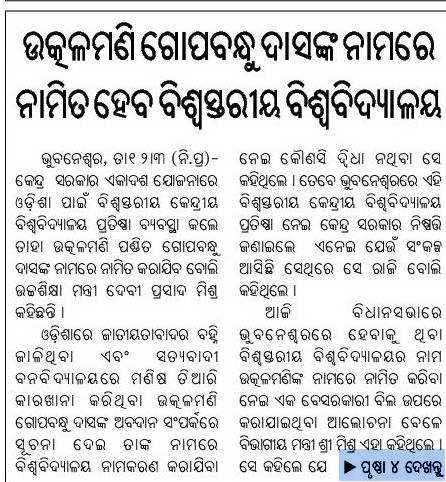
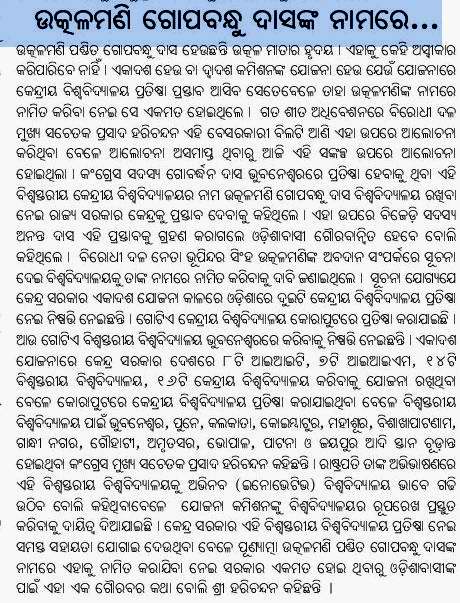
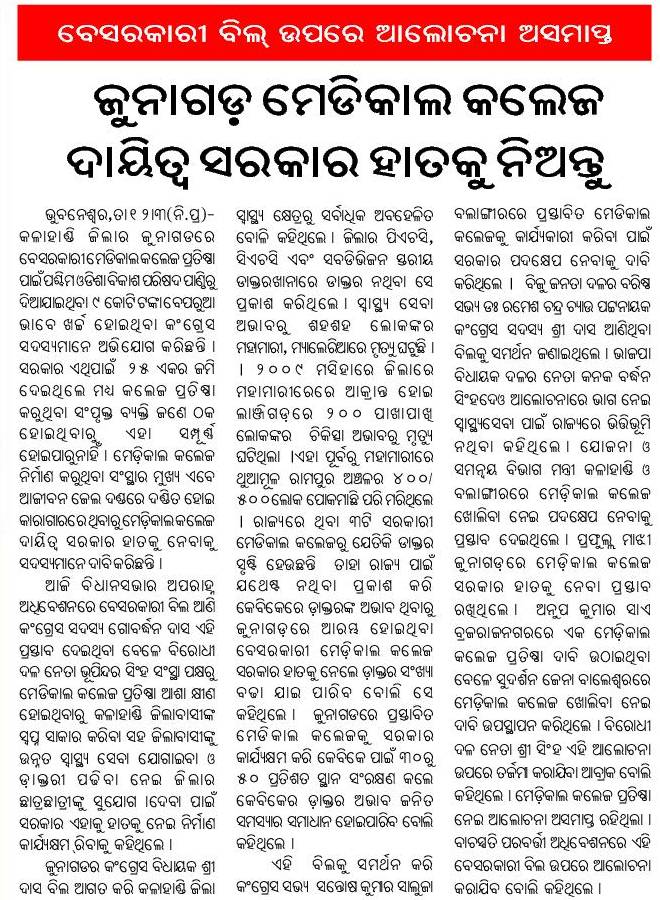
March 14th, 2010
Following is an excerpt from http://www.rourkelacity.com/top-news/naveen-patnaik-assured-and-indicates-green-signal-for-esic-medical-college-at-rourkela/.
Today under the leadership of Dr. Prafulla Majhi ( MLA , Talsara Constituency, Sundargarh ) about 6 MLAs from Sundargarh, Jharsuguda, Keonjhar met the Chief Minister Shri Naveen Patnaik and appraised him about the discontent among the civil society and people at Rourkela and Sundargarh on the on going issue of locating the ESIC Medical College. After giving a calm hearing to the MLAs , Naveen Patnaik said, being ESIC Medical College is a central Govt. project, the State Govt. doesn’t have any problem if the ESIC Corporation decides this to be at Rourkela. The state will facilitate accordingly and allocate the land. He further assured about checking the status of the project and do his best for Rourkela and its people. At the same time 20 representatives of people from the above districts, also handed over a memorandum for setting up ESIC Medical College and Hospital at Rourkela to the Chief Minister which he gladly accepted.
I hope this solves all the technical issues and the ESIC hospital and medical college is quickly established in Rourkela.
Assuming the above happens Rourkela would have a very good momentum towards becoming a Tier II city in India. Some of the other things that are happening in parallel are: (i) Faster progress with respect to BPUT (ii) Good progress on Hi-Tech Medical college (iii) Proposal for a metropolitan university in Rourkela and much more. In terms of knowledge infrastructure Rourkela would then have:
- One institute of National importance: NIT
- Two Universities: BPUT and Metropolitan University
- Two medical Colleges: Hi-Tech and ESI
- Two existing engineering colleges (Padmanava and Purushottam) and one more in pipeline (Rourkela Institute of Technology)
- Good management institutes in RIMS Rourkela and IIPM Kansbahal.
I hope now Rourkela will have the momentum and its people will take their own initiatives so that steps such as the ones we earlier mentioned in https://www.orissalinks.com/archives/3480 will be taken and Rourkela will march towards becoming a Tier II city of India.
Among people driven initiatives the first one to be taken is to push SAIL to create a medical college and an engineering college in Rourkela and approaching top institutions in Odisha and India to open a campus in Rourkela.
March 13th, 2010
Update:Following is from PIB http://pib.nic.in/release/release.asp?relid=59525.
LOK SABHA
The Government has approved setting up of six AIIMS-like institutions in the States of Bihar (Patna), Chhattisgarh (Raipur), Madhya Pradesh (Bhopal), Orissa (Bhubaneswar), Rajasthan (Jodhpur) and Uttarakhand (Rishikesh) under the first phase of Pradhan Mantri Swasthya Suraksha Yojana (PMSSY). It is also proposed to set up two more institutions, one each in the State of Uttar Pradesh and West Bengal in the second phase of PMSSY.
Each institution will have a 960 bedded hospital (500 beds for the medial college hospital; 300 beds for Specialty/Super Specialty; 100 beds for ICU/Accident trauma; 30 beds for Physical Medicine & Rehabilitation and 30 beds for Ayush ) intended to provide healthcare facilities in 42 specialty/super-specialty disciplines.
Bids for construction of hospital and medical college complex for the six AIIMS-like institutions in the first phase are under process. The timeline for completion of these works is the second half of 2012.
This information was given by Minister for Health & Family Welfare, Shri Ghulam Nabi Azad in written reply to a question raised in Lok Sabha today.
Following are excerpts from a report in Indian Express.
… The AIIMS at Bhopal is likely to cost Rs 849.46 crore, Bhubaneswar Rs 820.49 crore, Jodhpur Rs 777.64 crore, Patna Rs 858.43 crore, Raipur Rs 803.84 crore and Rishikesh Rs 820.15 crore.
… the officials suggested that certain operations of these new institutes should be outsourced through Public Private Partnership (PPP). Such operations include outsourcing routine/housekeeping services, hospital information system to a professionally managed agency and outsourcing of nursing orderlies and ward boys and other staff. “This strategy the health ministry officials argued would ensure minimal Group C & D employees,” a Plan panel source said. Nearly 95 per cent of the construction work for residential complexes for Jodhpur and Raipur Institutes has been completed, 45 per cent work has been completed for Patna and Rishikesh, while the construction for Bhopal and Bhubaneswar is gradually picking up,” he said. So far about 152 bids have been received including 57 for hospitals and 95 for medical colleges and hostels. “The technical and financial evaluation would be completed by March 30 and work is likely to commence by June 10,” the source said, quoting health ministry officials.
March 9th, 2010
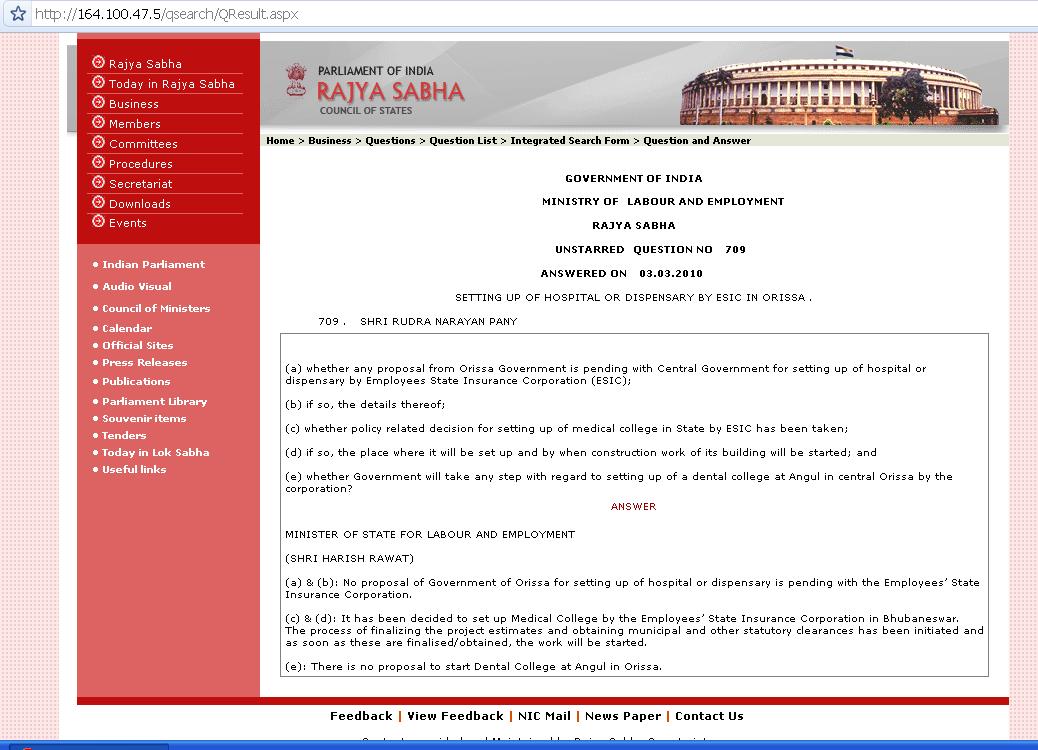
March 7th, 2010
Following is from the PIB release http://pib.nic.in/release/release.asp?relid=59071.
Setting up of AIIMS like Institutes
|
| |
17:24 IST |
The States identified for setting up of AIIMS-like institutions are based on criteria of various socio-economic indicators like human development index, literacy rate, population below poverty line and per capita income and health indicators like population to bed ratio, prevalence rate of serious communicable diseases, infant mortality rate etc.
Details of the proposed Institutes are as follows:-
Annexure-I
I. SETTING UP OF AIIMS-LIKE INSTITUTIONS
Ist Phase
1. Bhopal (Madhya Pradesh)
2. Bhubaneswar (Orissa)
3. Jodhpur (Rajasthan)
4. Patna (Bihar)
5. Raipur (Chattisgarh)
6. Rishikesh (Uttarakhand)
2nd phase
1. Uttar Pradesh
2. West Bengal.
II. Upgradation of medical college institutions
|
S.No
|
State
|
Name of institution
|
|
Ist phase
|
|
|
1.
|
Andhra Pradesh
|
Nizam Institute of Medical Sciences, Hyderabad.
|
|
Sri Venkateswara Institute of Medical Sciences,Tirupati
|
|
2.
|
Gujarat
|
B.J. Medical College, Ahmedabad
|
|
3.
|
Jammu & Kashmir
|
Govt. Medical College, Jammu
Govt. Medical College, Srinagar
|
|
4.
|
Jharkhand
|
Rajendra Institute of Medical Sciences, Ranchi
|
|
5.
|
Karnataka
|
Govt. Medical College, Bangalore
|
|
6.
|
Kerala
|
Govt. Medical College, Thiruvananthapuram
|
|
7.
|
Maharashtra
|
Grants Medical College, Mumbai
|
|
8.
|
Tamil Nadu
|
Govt. Mohan Kumaramangalam Medical College,Salem
|
|
9.
|
Uttar Pradesh
|
Sanjay Gandhi Postgraduate Institute of Medical Science, Lucknow
Institute of Medical Sciences, Banaras HinduUniversity, Varanasi
|
|
10.
|
West Bengal
|
Kolkata Medical College, Kolkata.
|
|
2nd Phase
|
|
|
1.
|
Haryana
|
Pandit B.D. Sharma Postgraduate Institute of Medical Sciences, Rohtak
|
|
2.
|
Himachal Pradesh
|
Dr. Rajendra Prasad Govt. Medical College, Tanda
|
|
3.
|
Maharashtra
|
Govt. Medical College, Nagpur
|
|
4.
|
Punjab
|
Govt. Medical College, Amritsar
|
|
5.
|
Tamil Nadu
|
Govt. Medical College, Madurai
|
|
6.
|
Uttar Pradesh
|
Jawaharlal Nehru Medical College of AMU, Aligarh
|
Annexure-II.
I. Setting up of six AIIMS-like institutions in the Phase-I of PMSSY
(a) Medical College & Hospital Complex
Bids have been invited and are under evaluation. Bids are likely to be finalized by April, 2010. Work for Medical College and Hospital Complex is likely to start by June, 2010 and complete by June, 2012.
(b) Residential Complex
(Rs. in Crore)
|
S.
No
|
Site
|
Current Status
(% of work completed)
|
Funds released
(upto 03.03.2010)
|
|
1.
|
Jodhpur
|
95
|
25.95
|
|
2.
|
Patna
|
50
|
18.76
|
|
3.
|
Rishikesh
|
50
|
43.11
|
|
4.
|
Bhubaneswar
|
15
|
19.93
|
|
5.
|
Raipur
|
95
|
28.99
|
|
6.
|
Bhopal
|
20
|
4.39
|
|
|
|
|
|
II. Two new AIIMS-like institutions being set up under Phase-II
. Location of AIIMS-like institutions proposed to be set up in Uttar Pradesh and West Bengal is being finalized in consultation with the respective State Governments.
III. Upgradation of medical college institutions
(Rs. in Crore)
|
S.
No
|
Name of the institution
|
Current Status
(% of work completed)
|
Funds released
(upto 03.03.2010)
|
|
Civil work
|
Procurement of medical equipments
|
|
1st Phase of PMSSY
|
|
|
|
|
1
|
ThiruvananthapuramMedical College
|
99.5
|
44.66
|
33.86
|
|
2
|
Salem Medical College
|
94
|
54.47
|
–
|
|
3
|
Bangalore MedicalCollege
|
89
|
45.00
|
34.99
|
|
4
|
Kolkata MedicalCollege
|
60
|
30.23
|
9.31
|
|
5
|
SGPGIMS, Lucknow
|
67
|
45.76
|
27.03
|
|
6
|
NIMS, Hyderabad
|
78
|
74.23
|
–
|
|
7
|
Jammu MedicalCollege
|
89
|
45.21
|
21.37
|
|
8
|
Srinagar MedicalCollege
|
39
|
20.76
|
34.60
|
|
9
|
IMS, BHU, Varanasi
|
37
|
34.35
|
22.05
|
|
10
|
RIMS, Ranchi
|
15
|
21.20
|
23.85
|
|
11
|
BJ Med. College,Ahmedabad
|
50
|
7.00
|
37.23
|
|
12
|
SVIMS, Tirupati
|
70
|
–
|
39.55
|
|
13
|
Grants Med. College, Mumbai
|
65
|
–
|
57.83
|
|
2nd Phase of PMSSY
|
|
|
|
|
14.
|
Government MedicalCollege, Nagpur
|
10
|
–
|
40.00
|
|
15.
|
Government MedicalCollege, Amritsar
|
Tender process initiated
|
–
|
–
|
|
16.
|
Pandit B.D. Sharma Postgraduate Institute of Medical Sciences,Rohtak
|
Upgradationplans of all these four medical colleges are under finalization
|
–
|
–
|
|
17
|
Dr. Rajendra Prasad Govt. Medical College,Tanda
|
–
|
–
|
|
18
|
Govt. Medical College,Madurai
|
–
|
–
|
|
19
|
Jawaharlal NehruMedical College of AMU, Aligarh
|
–
|
–
|
This information was given by Minister for Health & Family Welfare, Shri Ghulam NabiAzad in written reply to a question raised in Lok Sabha today.
DS/GK
|
March 5th, 2010
Following from PIB release http://pib.nic.in/release/release.asp?relid=58927.
The Cabinet Committee on Economic Affairs today approved, in order to meet the shortage of nurses, setting up of 132 Auxiliary Nursing and Midwifery (ANM) Schools under the Scheme of Upgradation / Strengthening of Nursing Services (Human Resource for Health) in the high focus states like Bihar, Chattisgarh, Himachal Pradesh, Jharkhand, Jammu & Kashmir, Madhya Pradesh, North Eastern States, Orissa, Rajasthan, Uttarakhand, Uttar Pradesh, West Bengal and other districts in the country preferably which do not have Auxiliary Nursing and Midwifery schools.
The schools will be opened in these states at a total cost of Rs.660 crore with a cost sharing pattern of 85:15 between the Central Government and the States. The expenditure on the part of Central Government would be Rs.561 crore and the States will contribute Rs.99 crore.
The effective implementation of the Scheme is expected to increase the availability of trained nursing manpower and to improve the quality of nursing education in the backward and special category States of the country. This would also facilitate improvement in the quality of nursing services in the Hospitals.
Following is from PIB release
http://pib.nic.in/release/release.asp?relid=58926.
The Cabinet Committee on Economic Affairs today approved establishment of 137 General Nursing and Midwifery (GNM) Schools under the Scheme of Upgradation / Strengthening of Nursing Services (Human Resource for Health) in the high focus states like Bihar, Chattisgarh, Himachal Pradesh, Jharkhand, Jammu & Kashmir, Madhya Pradesh, North Eastern States, Orissa, Rajasthan, Uttarakhand, Uttar Pradesh, West Bengal and other districts in the country preferably which do not have General Nursing and Midwifery schools.
The schools will be opened in these states at a total cost of Rs.1370 crore with a cost sharing pattern of 85:15 between the Central Government and States. The expenditure on the part of Central Government would be Rs.1164.50 crore and the states are to contribute Rs.205.50 crore.
March 4th, 2010
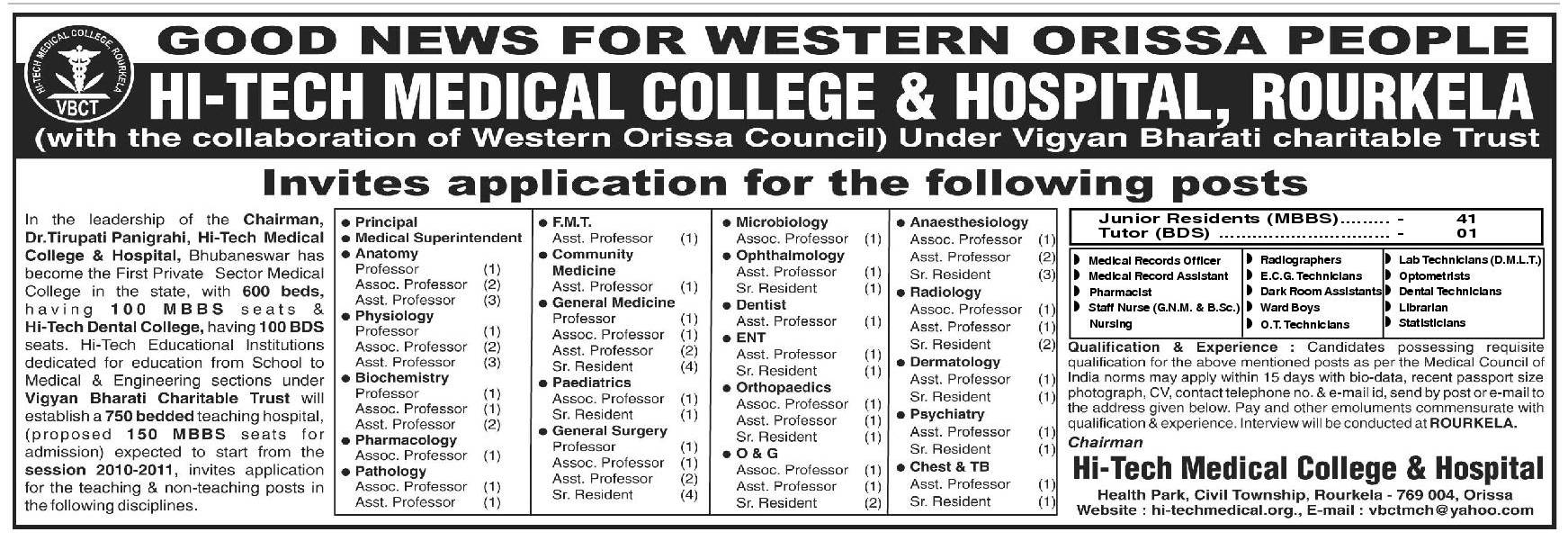
The ad says they are expecting it to start in 2010-11. Perhaps someone from Rourkela can tell us how far the construction has progressed. Any photos would be appreciated.
March 3rd, 2010
Next Posts
Previous Posts






